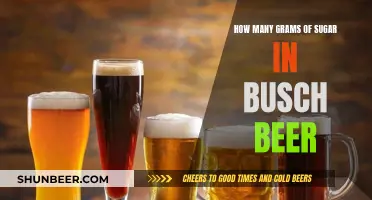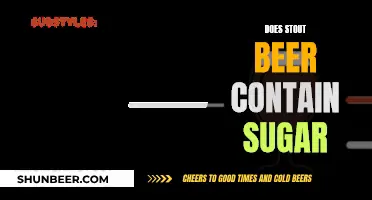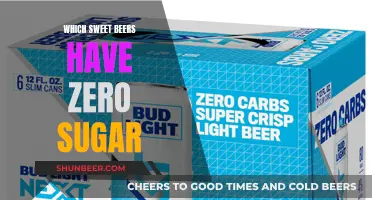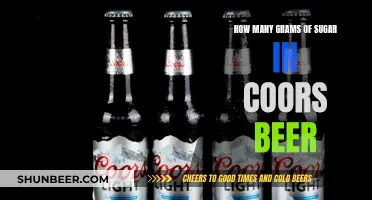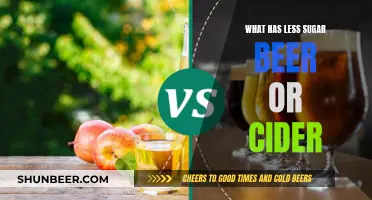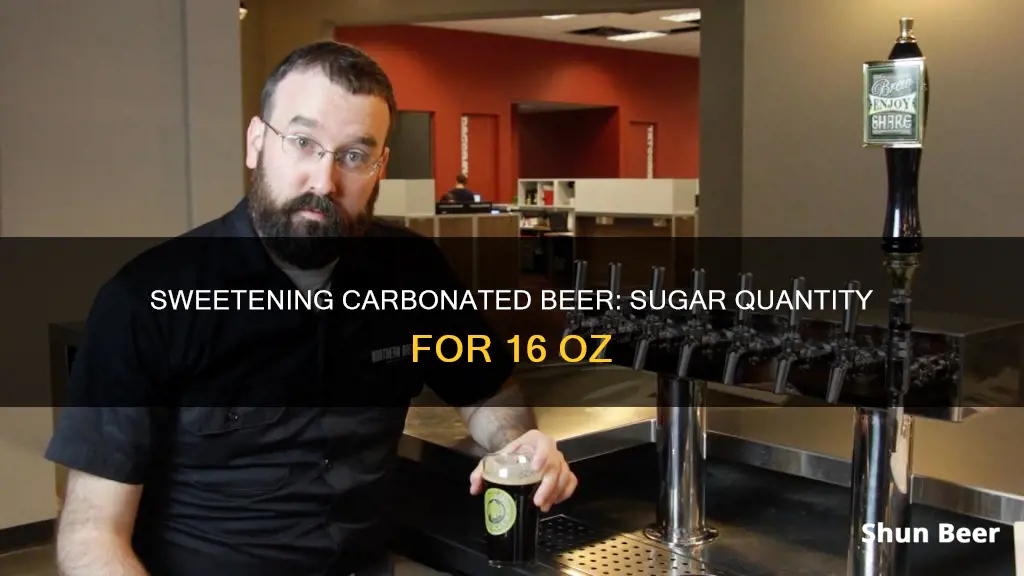
Carbonation is described in terms of volumes of carbon dioxide (CO2). The colder the liquid, the more CO2 can be held in solution. The amount of carbonation in a finished beer can be controlled by adjusting the amount of priming sugar in the priming solution. Many types of sugar can be used for carbonation, including corn sugar, table sugar, and dry malt extract. The amount of sugar used depends on the temperature of the beer, its volume, the type of sugar, and the level of carbonation desired. For a 16 oz beer, the amount of sugar required for carbonation will depend on the type of sugar used and the desired level of carbonation.
What You'll Learn

Priming sugar calculation
Priming sugar is a crucial component in the final stages of brewing beer, ensuring the beverage is adequately carbonated and has that refreshing fizz. The process of adding priming sugar to beer is known as bottle priming or bottle conditioning, and it involves initiating a "re-fermentation" in the bottle to create carbonation. This guide will outline the steps and calculations for priming 16 oz of beer.
Understanding Priming Sugar
Priming sugar is simply any fermentable sugar added to beer to induce carbonation and enhance its flavour and aroma. Common types of priming sugar include corn sugar (dextrose), table sugar (sucrose), and dry malt extract (DME). It's important to note that not all sugars are created equal, and some may alter the intended flavour of the beer. For instance, corn sugar is often favoured by novice brewers as it doesn't influence the taste of the final product.
Calculating Priming Sugar Amount
The amount of priming sugar required depends on several factors, including the type of sugar, the volume and temperature of the beer, and the desired level of carbonation. Online priming sugar calculators can be incredibly helpful in determining the precise quantity of sugar needed. However, it's essential to input accurate data to ensure optimal results.
As an example, let's consider priming 16 oz (0.47 litres) of an American ale with corn sugar. We'll assume a target carbonation level of 2.6 volumes (5.1 g/L) and a fermentation temperature of 71°F (21.7°C), resulting in a residual carbonation of 0.807 (1.58 g/L).
Using the formula for corn sugar:
CF + 0.5 x (0.91 x D) / VB = CB
Where:
- CF is the residual carbonation in grams/litre
- D is the amount of corn sugar in grams
- VB is the volume of beer in litres
- CB is the target carbonation level in grams/litre
We can calculate the amount of corn sugar needed:
58 + 0.5 x (0.91 x D) / 0.47 = 5.1
Solving for D, we find that D = 138.4 grams or approximately 4.9 ounces.
Preparing the Priming Solution
Once you've calculated the required amount of priming sugar, it's time to create the priming solution. Bring 16 ounces (0.47 litres) of water to a boil and add the calculated amount of priming sugar, stirring until it dissolves completely. Set this solution aside while you prepare your bottling bucket and sanitise your bottles.
Bottling and Carbonation
Carefully siphon your beer into the bottling bucket, being cautious not to disturb the sediment at the bottom. Add the priming solution and gently mix without splashing, as oxygen introduction can negatively impact the flavour. Bottle the beer, leaving about 0.75 to 1 inch of headspace for carbonation.
Store the bottles at room temperature for approximately two weeks to allow fermentation to complete. After this period, chill a bottle and test it. If it's not adequately carbonated, allow the remaining bottles to age for a few more days. Once you're satisfied with the carbonation level, chill the bottles and enjoy your refreshing, perfectly carbonated beer!

Carbonation levels
Carbonation is described in terms of volumes of carbon dioxide (CO2). The more volumes of gas, the more carbonated the liquid will be. For example, English cask beer is around 1.5 volumes, whereas champagne can be up to 7.0 volumes. The amount of carbonation in a finished beer can be controlled by adjusting the amount of priming sugar in the priming solution.
The amount of priming sugar needed to carbonate a beer depends on the type of sugar and the desired level of carbonation. For instance, the standard amount of corn sugar (dextrose) needed to prime five gallons of beer is 3/4 cups (6 ounces or 113 grams), while for table sugar (sucrose) it is 2/3 cup (5.3 ounces or 150 grams), and for light dry malt extract (DME) it is 1 1/4 cups (181 grams). These measurements can be adjusted to hit the target carbonation level and brew the best beer possible.
There are also priming sugar calculators available online that can help determine the amount of priming sugar needed based on the desired carbonation level and the type of beer being brewed. These calculators take into account factors such as the residual carbonation present in the beer after fermentation, the volume of the beer, and the type of sugar being used.
It is important to note that the temperature of the beer also affects carbonation levels. Colder liquids can hold more CO2, so the colder the finished beverage, the more residual CO2 will be in the solution. This is why beers are often over-carbonated.
Additionally, different types of sugars can be used for bottle carbonation, including corn sugar (dextrose), table sugar (sucrose), or dry malt extract (DME). These sugars provide a source of nutrition for the yeast, which creates carbonation in the beer.
In summary, achieving the desired carbonation level in a beer involves understanding the target carbonation, the amount and type of priming sugar needed, and the temperature of the beer. By using priming sugar calculators or manual calculations, brewers can ensure they add the correct amount of sugar to achieve the desired carbonation level in their beer.

Bottle conditioning
How to Bottle Condition Beer
Firstly, you will need to prepare your bottles and bottle caps by cleaning and sanitising them. You will also need to prepare your priming solution by boiling water and dissolving your priming sugar of choice. Popular priming sugars include corn sugar (dextrose), table sugar (sucrose), and dry malt extract (DME).
Once your priming solution is prepared, add it to your bottling bucket, being careful not to splash and introduce oxygen to the brew, which can cause problems with the flavour. Then, carefully siphon your brew from your carboy into the bottling bucket and mix it with the priming sugar solution.
After mixing, transfer your brew to your bottles, filling them to the top. Then, cap your beers with a handheld capper and set them aside in a dry, room-temperature place for the yeast to remain active and generate carbonation as they consume the priming sugar solution.
The amount of priming sugar you will need depends on the type of sugar, the volume of your brew, the temperature of the beer, and the level of carbonation desired. For example, the brewer's rule of thumb for every five gallons of beer is 3/4 cups (6 ounces, or 113 grams) of corn sugar (dextrose), ⅔ cup (5.3 ounces, or 150 grams) of table sugar, or 1 ¼ cups (181 grams) of light dry malt extract (DME).
You can also use priming sugar tablets, which eliminate the need for calculations and reduce the risk of bottle bombs due to over-priming.
Storing Bottle-Conditioned Beer
After priming and filling, the newly bottled beer should be stored at 70-75°F for 2-3 weeks or until fully carbonated. After this time, the bottles can be chilled or stored below 60°F to stabilise the beer.

Priming sugar types
Priming sugar is any fermentable sugar added to beer to create carbonation and give it a fizzy texture. While any sugar type can be used for priming, some sugars may be more beneficial to the final product than others.
Simple Sugars
Simple sugars such as white table sugar or corn sugar can be used for priming a beer, but they won't add to or enhance the flavour or aroma of the beer. Corn sugar, also known as dextrose, is a neutral sugar that doesn't alter the flavour of the beer during carbonation. It is also very soluble and easy for the yeast to digest.
Natural Sugars
Using more "natural" unrefined sugars such as dark brown sugar or honey will not only give the beer a fizz but will also amplify its taste and aroma.
Dry Malt Extract (DME)
DME is an unfermented wort that has been dried into powder form. It helps add flavour and body to the beer, and some brewers argue that it gives finer bubbles than sugar. However, priming with DME can take much longer than sugar, which may cause the bubbles to appear smaller initially.
Priming Sugar Substitutes
Some popular priming sugar substitutes include demerara sugar, agave nectar, honey, treacle, maple syrup, molasses, and Belgian candi syrup. Anything with sugar can be used to prime beer, but it's important to note that using too much active sugar can lead to over-priming, causing issues like swollen caps or exploding bottles.

Priming with honey
How to Prime with Honey
Next, get your bottle caps ready. Make sure to sanitise these too.
Then, prepare your priming solution. To ensure the sugar dissolves evenly through your beer, boil about two cups of water and dissolve your honey in it. Boiling ensures sanitation and allows you to use less water as more sugar can be dissolved in hot water than in cold. Pour the solution into your brew and mix it in. Be careful not to stir any sediment at the bottom of your bucket back into your beer.
When combining your beer and priming solution, make sure that you do not let it splash, as this introduces oxygen into the brew, which can cause problems with the flavour.
How Much Honey to Use
To work out how much honey to use, you can use a priming sugar calculator. Simply add the fermentation temperature and the CO2 volume required, or choose the beer style and how many gallons of brew you want to batch prime. The results will give you how much honey to use in grams or ounces.
Other Priming Sugars
Other priming sugars and substitutes include corn sugar, table sugar, dry malt extract, demerara sugar, agave nectar, treacle, maple syrup, molasses, and Belgian candi syrup.
Frequently asked questions
It depends on the type of sugar used. For table sugar, 1 teaspoon is required. For brown sugar, an overfilled 1/2 teaspoon is needed.
It is recommended to add sugar to the beer in bulk, rather than adding it to individual bottles. This ensures that the sugar is evenly distributed in the beer.
Corn sugar (dextrose) is the most widely available commercial priming sugar and does not influence the taste of the beer. Other options include table sugar (sucrose) and dry malt extract (DME).
After priming and bottling, the beer should be stored at 70-75 degrees Fahrenheit for 2-3 weeks or until fully carbonated.


